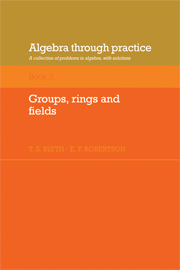1 - Groups
Published online by Cambridge University Press: 05 June 2012
Summary
Abstract algebra is basically a study of sets with binary operations. A binary operation (or law of composition) on a set E is a mapping f:E × E → E described variously by (x, y) → x ✶ y, (x, y) → x + y, (x, y) → xy, etc. When E is finite it is sometimes convenient to represent a binary operation on E by means of a Cayley table, the interpretation of which is that xi ✶ xj appears at the intersection of the ith row and the jth column (Fig. 1.1). A binary operation
✶ on E is associative if (∀x, y, z ∈ E)x ✶ (y ✶ z) = (x ✶ y) ✶ z. A group is a set G on which there is defined an associative law of composition ✶ such that
(a) there is an identity element (i.e. an element e such that (∀x∈G)e ✶ x = x ✶ e);
(b) every element of G has an inverse (i.e. for every x ∈ G there exists y ∈ G such that x ✶ y = e = y ✶ x).
When the law of composition is written as addition (respectively multiplication) we denote the identity element by 0 (respectively 1) and the inverse of x ∈ G by - x (respectively x-1). Elements x, y of a group G are said to commute if xy = yx, and the group is said to be abelian if every pair of elements commute.
In studying algebraic structures there are two important notions to consider. The first is that of a substructure, and the other is that of a structurepreserving mapping from one such structure to another.
- Type
- Chapter
- Information
- Algebra Through PracticeA Collection of Problems in Algebra with Solutions, pp. 1 - 18Publisher: Cambridge University PressPrint publication year: 1984



